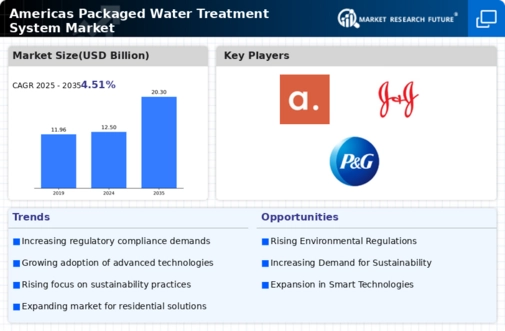Market Trends
Key Emerging Trends in the Americas Packaged Water Treatment System Market
Government initiatives play a pivotal role in shaping the trajectory of the packaged water treatment system market, with a focus on improving health standards and safeguarding water resources. In the United States, a series of initiatives and frameworks have been implemented to address the critical importance of clean water, protect public health, and ensure the quality of water bodies. The inception of the national clean water framework in 2011 marked a significant milestone in the country's commitment to these objectives.
The U.S. government's national clean water framework was introduced to comprehensively address the health of America's water bodies. Recognizing the intrinsic link between clean water and public health, the framework represents a concerted effort to establish policies that promote effective water management and preserve water quality. Collaborative endeavors between the government and policymakers underscore a commitment to creating sustainable solutions for water-related challenges.
One of the primary objectives of the clean water framework is to explore innovative approaches aimed at protecting public health by minimizing contaminants in the nation's drinking water. This multifaceted initiative involves strategic measures to identify and reduce the presence of harmful substances in drinking water sources. By leveraging advancements in water treatment technologies, the framework seeks to enhance the safety and quality of the water supply, contributing to overall public well-being.
At the forefront of water quality regulation in the United States is the Environmental Protection Agency (EPA), operating under the Safe Drinking Water Act (SDWA). Enacted as federal law, the SDWA serves as a robust mechanism for safeguarding public drinking water supplies across the nation. The EPA, through the SDWA, implements a range of technical and financial programs aimed at ensuring the integrity and safety of drinking water sources.
The Safe Drinking Water Act empowers the EPA to establish and enforce regulations that set specific standards for drinking water quality. These standards encompass a comprehensive list of contaminants, and the EPA continuously evaluates and updates them to reflect advancements in scientific understanding and emerging challenges. By doing so, the agency plays a crucial role in mitigating potential health risks associated with drinking water consumption.
The implementation of technical and financial programs under the SDWA further reinforces the government's commitment to enhancing water treatment capabilities. Technical programs encompass research, monitoring, and assessment activities that inform the development of effective water quality regulations. Financial programs, on the other hand, provide critical funding to support water infrastructure projects, ensuring the modernization and optimization of water treatment facilities nationwide.
The government's proactive stance on water quality and treatment is particularly pertinent in the context of packaged water treatment systems. These systems, often modular and adaptable, align with the goals of the national clean water framework by offering swift and efficient solutions to address specific water treatment needs. Whether deployed for emergency situations, remote locations, or as part of regular water treatment infrastructure, packaged systems play a complementary role in the broader government-led efforts to ensure safe and clean drinking water.
Government initiatives, exemplified by the national clean water framework and the Safe Drinking Water Act in the United States, underscore the commitment to improving health standards and protecting water resources. The collaboration between the government, policymakers, and regulatory bodies reflects a comprehensive approach to water management, with a strong emphasis on research, regulation, and financial support. As the government continues to prioritize water quality, packaged water treatment systems emerge as integral components in achieving the overarching goal of ensuring access to safe and clean drinking water for all.






Leave a Comment